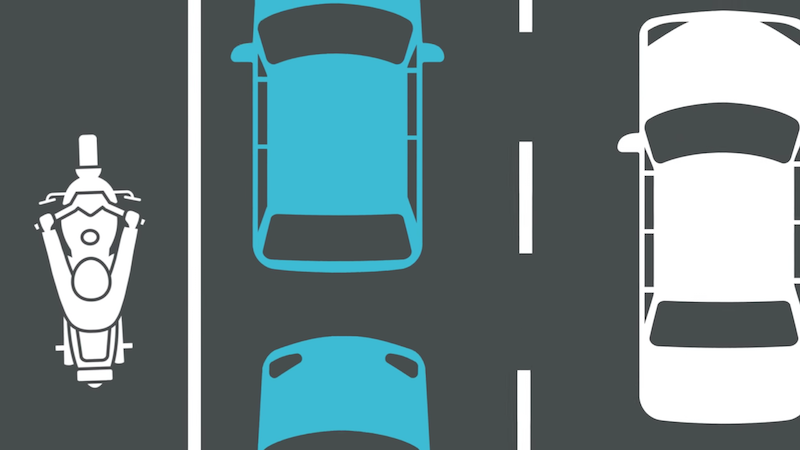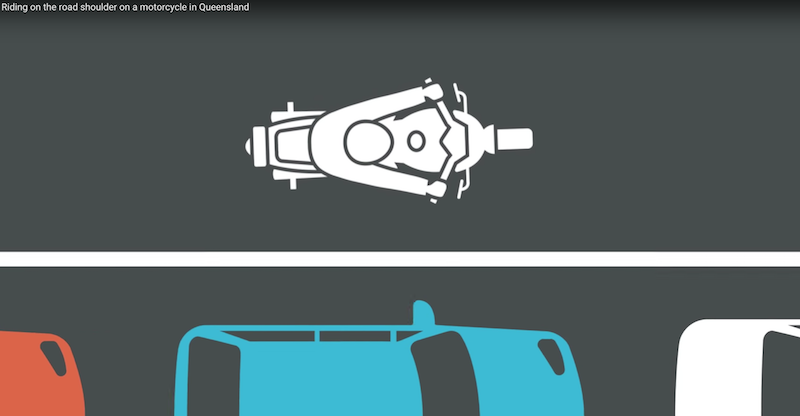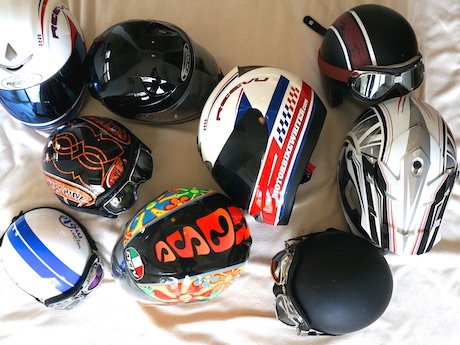A proposal to make lane filtering rules uniform across Australia seeks to ban edge filtering, according to the Australian Motorcycle Council.
In its submission to the National Transport Commission, the AMC says the Australian Road Rules Maintenance Group (a group outside of the NTC made up of representatives from Austroads) has confused edge filtering with kerbside filtering.
Edge filtering is the use of the emergency/breakdown lane or road shoulder on highways while kerbside filtering is riding between traffic and the kerb.
(The full AMC submission is printed at the end of this article.)
Differentiate edge and lane filtering
AMC submission author Rob Salvatore says the wording in the road rules should clearly differentiate between kerbside filtering and edge filtering.
“It looks like ARRMG are trying to be get both with the one set of words, and we are calling them out on it,” he says.
The AMC wants to examine any evidence that supports banning edge filtering which is allowed in Queensland on roads posted with speeds of 90km/h or above.
The AMC submission does not directly call for edge filtering in all states in their submission.
“If there’s no clause against edge filtering in the Australian Road Rules then it at least leaves it open for the state peak advocacy bodies to advocate for edge filtering in their state,” Rob says.
“The Victorian Motorcycle Council certainly advocated for it in its filtering framework in the lead up to filtering’s introduction.”
However, the Victorian Government chose not to include edge filtering citing safety concerns.
“This appears to have been a somewhat conservative assessment as the experience in Queensland has not borne out these concerns,” the AMC submission states.
“The practice has not increased rider danger and is in fact consistent with the principles of vulnerable road user traffic separation. It is very much appreciated by Queensland riders as a common-sense application of motorcycle use.
Helmet laws
The AMC submission also seeks to simplify the conformity of helmets to avoid riders being fined for attaching a Bluetooth unit or camera, or having tinted visors.
For years the AMC has advocated that helmet compliance should only be valid up to the point of sale, not for the lifetime of the helmet.
In its complex and lengthy submission, the AMC seeks to comply with West Australian regulations that allow helmets with European ECE22.05 and Australian (AS 1968:1988 and AS/NZS 16598:2006) stickers, labels or certifying marks.
The submission also suggests the following “fit-for-use” parameters for approved helmets:
- It must be correctly fastened;
- A helmet visor or goggles with visible light transmission of less than 50% must not be used between sunset and sunrise;
- The helmet outer shell must not be modified by cutting, drilling or show visible cracks;
- The impact absorption liner must be intact and in sound condition; and
- The retention system must be sound and functional.
The South Australian Ride to Review group also made a submission to the NTC that seeks similar point-of-sale compliance together with “in-service” guidelines that also include the allowance for the fading of compliance stickers.
Motorbike control laws

Over the past couple of years several states have passed more realistic rules on motorcycle control. They include allowing riders to push a bike without having to wear a helmet, stand on the footpegs and remove a foot from the pegs to stretch.
The NTC draft proposal attempts to make uniform rules on motorcycle controls.
However, the AMC submission says the rules need to be simplified.
They suggest adopting Queensland’s version: “The rider of a motorbike that is moving (other than a rider who is walking beside and pushing a motorbike), or the rider of a motorbike that is stationary but not parked, must be astride the rider’s seat.”
Full text of the AMC submission
ABOUT THIS SUBMISSION :
The Australian Motorcycle Council (AMC) is pleased to make a submission to the National Transport Commission (NTC) in response to the Australian Road Rules 12th Amendment Package Consultation Draft June 2017 (herein referred to as “the amendments”). The submission was prepared by the Victorian Motorcycle Council (VMC), authored by VMC Chair: Rob Salvatore B.Eng(Mech) RoSPA(Dip) on behalf of and for the AMC as AMC Data subcommittee Chair.
This submission represents a distillation of a national conversation between representatives of the AMC member organisations and its national network of AMC associates and delegates, regarding proposed changes to three key motorcycling related Australian Road Rules (ARR). The information in this submission is for all intents and purposes, factual, correct, accurate and relevant.
The AMC would like to formally recognise the key contribution made by Guy Stanford, with significant contributions from Chris Mearns, Bruce Campbell and Rob Salvatore, and thank all those that participated in the behind the scenes discussions and phone calls on these matters of national importance.
The submission is in four parts; the first regarding issues in the process of ARR maintenance development and updating, followed by individual sections on each of the three key motorcycling related ARR amendments, namely RR151A, RR270 and RR271.
Throughout this submission, the term “motorcycle” is used to describe any variant of a powered two or three wheeled single track vehicle to which the discussed road rules would apply.
The AMC and its representatives stand ready to respond to and support any part of this submission and any related queries.
AUSTRALIAN MOTORCYCLE COUNCIL – ABOUT US:
The Australian Motorcycle Council (AMC) is a volunteer organisation advocating for and representing Australian riders at the national level on matters of motorcycle safety and riders rights.
Its membership is made up of organisations formed in the interests of motorcycling and includes the peak motorcycle representative body from each state or territory amongst its members. The association’s principal objectives are to promote and improve motorcycle road safety, motorcycle use and motorcycle awareness by making submissions on national motorcycling issues and by working with the Federal Government, its agencies and organisations and other national non-Government organisations. Australian Motorcycle Council – Submission to NTC, 12th Amendment ARRs, 8 August 2017 3
Australian Road Rules Maintenance – Significant Issues With the Process
The process of maintaining the Australian Road Rules (ARR’s) is an important one. The ARR’s have no legal power in and of themselves, but form a set of model rules that each state essentially adopts as their state road rules, with some minor differences reflecting state idiosyncratic matters.
From a public standpoint, the NTC is seen as the organisation that runs and administers this maintenance process and is seen as the organisation that holds the most up-to-date copy of the model ARR’s. In fact, that is not the case.
The Australian Road Rules Maintenance Group (ARRMG) is a group outside of the NTC, made up of representative individuals from the Austroads Ltd organisation, an organisation essentially formed by the various state road authorities. It gathers input and deliberates on proposed amendments to the ARR’s. The NTC appears to only manage the public interface and submission gathering aspect once a set of proposed amendments has been settled on. What happens next is a little unclear. The NTC does not appear to play any further part in the actual ARR maintenance process, despite what it states on its1 or the Department of infrastructure2 websites. ARRMG appears to take and deliberate on the submissions, however this is an educated guess as the ARRMG does not have an official public presence and its outputs or deliberations do not appear publically anywhere.
1 “The NTC has ongoing responsibility for the maintenance of the ARRs” https://www.ntc.gov.au/current-projects/australian-road-rules-maintenance/?modeId=1064&topicId=1083
2 “The National Transport Commission is responsible for the regular ‘maintenance’ of the Australian Road Rules to ensure they are up to date.” https://infrastructure.gov.au/roads/legislation/road_rules.aspx
3 http://transportinfrastructurecouncil.gov.au/
4 “The Transport and Infrastructure Council (the Council) approved the 11th amendment package on 6 November 2015, which we are currently incorporating into an update version of the AARs.” http://ntc.gov.au/roads/rules-compliance/the-australian-road-rules/past-reviews-amendments/
At some point, a finalised draft of the amendments is produced (presumably by ARRMG) and then submitted to the Transport Infrastructure Council (TIC)3 – which is essentially a council of state roads and transport ministers – for ratification and adoption. This decision is somehow then relayed back to the state road authorities who in time receive a copy of the updated ARR’s and prioritise consequent updates to their state road rules. Presumably the NTC has the role to publish the latest version of the ARR’s for the purposes of communicating them to the Australian community.
The public aspect of this process failed in respect of the previous ARR amendments.
The AMC participated in the Australian Road Rules 11th Amendment Package Consultation process and had noted that the February 2012 version of the ARR’s had remained unchanged on the NTC’s website. The conclusion drawn was that the 11th proposed amendments had not yet been ratified since the ARR’s had not been updated and no public announcement had been made by the TIC. In fact, the 11th proposed amendments had been ratified by the TIC in 20154 however there is no public mention of this in any of the official TIC communiques.
Even though the NTC website had initiated a call for public submissions in relation to 12th amendments, the website still referred to the February 2012 ARR’s which were the subject of the 9th amendments. Members of the AMC were wondering how the 12th amendments made sense when they were referring to ARR clauses that weren’t even in the current version of the publically available ARR’s. It turns out that this important updating step had been missed by the NTC. Australian Motorcycle Council – Submission to NTC, 12th Amendment ARRs, 8 August 2017 4
Direct approaches to the TIC secretariat (part of the Department of Infrastructure), could not produce TIC meeting minutes reflecting the formal decision which accepted and approved the 11th ARR amendments. Further, neither the NTC nor the TIC secretariat were able to point to where the body of ARRMG work was publically accessible, what the deliberations flowing from the 11th amendment public submissions were and what 11th ARR amendment document was presented to the TIC for ratification. As two groups with critical public roles in the ARR maintenance process, this was concerning.
Until these inquiries were made by the AMC, for all intents and purposes the public and official version of the ARR’s was the Feb 2012 version. Indeed, the ACT is still working from the 2012 version based on their official legislation website and the NT doesn’t have the most recent version of RR271 as part of its road rules, which leads one to assume that they too are not working with the latest version of the ARR’s. Did these jurisdictions just not get around to it or were they working from the belief that ARR circa 2012 was the most current version?
In motorcycling public forums and social media pages, discussion noted that the proposed 12th amendments appeared to roll back some of the RR271 gains captured in various state road rules around the country. The AMC was aware of most states having updated their road rules to reflect a more logical version of RR271, but this appeared to be more in response to lobbying from state peak motorcycle advocacy groups and the AMC rather than from rolling through the 11th ARR amendments. The 12th amendments appearing to roll back hard won gains generated derision and reputational damage particularly from those who in good faith were working towards understanding the proposed amendments in context of the current ARR’s.
The public submission process was already well underway when in response to these inquiries, the NTC quietly updated its website to point to the correct version of the ARR’s. The public submission process was not modified or extended and no public explanations ensued.
In 2008 the 8th ARR’s amendments were given an exemption from the Regulatory Impact Statement processes by the Office of Best Practice and Regulation5. It is not clear whether this was a one off or a precedent setting exemption, but it does appear that the ARR maintenance process has assumed ongoing exemption. One of the proposed amendments in relation to RR270 clearly has a regulatory impact but there is no hint of a RIS process commencing. This will be discussed in greater detail in the RR270 section.
5 https://www.legislation.gov.au/Details/F2009L04189/Explanatory%20Statement/Text
6 https://www.pmc.gov.au/resource-centre/regulation/best-practice-regulation-guide-ministerial-councils-and-national-standard-setting-bodies
It is understood that this section of the AMC’s submission is not pertinent to the actual proposed 12th ARR amendments, but it is being made to capture as a matter of public record, that matters of process and clear delineations of responsibility need a deeper and closer scrutiny. The entire process appears to be more convoluted than it needs to be and as a result, there are cracks into which important aspects can fall through. There’s also a question of whether this process and the adoption at the state level of changes it recommends without seemingly any further scrutiny, meets the COAG better regulation principles6. Indeed, the freight train of implementation is already well up to full speed by the time public consultation processes occur. Australian Motorcycle Council – Submission to NTC, 12th Amendment ARRs, 8 August 2017 5
RR 151A – Motorcycle Lane Filtering
The AMC and its member organisations applauds the proposed inclusion of motorcycle traffic filtering rules into the model ARR’s. Filtering fundamentally improves motorcycle safety by allowing a rider to manoeuvre their motorcycle away from the most likely zone of collision – the in-queue nose-to-tail collision. It also fundamentally improves congestion by reducing the number of cars on the road and the number of spots in the traffic queue taken up by motorcycles. 7
7 Wigan et al, (2000), Motorcycle Transport – Powered Two Wheelers in Victoria, Report for Vicroads by Oxford Systematics, Chapter 11.
Despite commonly held views that filtering must be more dangerous due to the proximity of vehicles and the danger presented by a sudden vehicle lane change, the filtering experiences of NSW, QLD, ACT, Victoria and more recently SA, do not bear out these views. This is not difficult to understand when one appreciates that the frequency of lane changes is significantly less than the frequency of stops and starts, and slow downs and speed ups that occur in congested traffic, each of which requires riders and drivers to respond accordingly, lest they collide with the vehicle ahead of them. Filtering deserves to be a legal practice nationwide.
The AMC was gratified to note that the proposed RR 151A amendment was not made in isolation, but that the consequent and necessary exemptions from lane use and indicating rules were also proposed. That being said, the amendments are not without issue.
Language Matters – Amendment Goes Over the Edge
It’s clear that the RR 151A amendment endeavours to codify the very clear and significant commonalities shared by each jurisdiction’s implementation of filtering. However the use of the term “edge filtering” is highly problematic as it is already a very clearly defined and historically successful practice/variant of filtering.
Queensland very clearly implemented and defined “Edge filtering”, which is the practice of motorcycles using the road shoulder or emergency lane of congested roads with a 90km/h or higher speed limit, at no greater than the legal filtering speed. This ostensibly limits the practice to freeways and major highways –arguably the safest roads to travel on.
Victoria looked closely at identical edge filtering regulations, however due to beliefs of road safety concerns, elected not to implement it. This appears to have been a somewhat conservative assessment as the experience in QLD has not borne out these concerns. The practice has not increased rider danger and is in fact consistent with the principles of vulnerable road user traffic separation. It is very much appreciated by QLD riders as a common-sense application of motorcycle use.
As a result of the above, amendment RR 151A (3) (a) as written, is an unnecessary and “too smart by half” over-reach. The commonality that the proposed amendment is trying to capture is ruling out filtering between a lane or line of vehicles and the immediately adjacent kerb. By defining this as edge filtering, ARRMG have overstepped.
The AMC strongly recommends a change in language to reflect the actual commonality shared by all jurisdictions, which is the prohibition of kerbside filtering, and requires ARRMG to show cause if it Australian Motorcycle Council – Submission to NTC, 12th Amendment ARRs, 8 August 2017 6
believes that the definition as proposed should be maintained. ARRMG would be requested to produce evidence to show that edge filtering is indeed sufficiently dangerous that its successful implementation and practice in QLD requires overturning.
The AMC is prepared to lobby and initiate FOI proceedings should the current wording stand and the requested evidence is not forthcoming. Australian Motorcycle Council – Submission to NTC, 12th Amendment ARRs, 8 August 2017 7
RR 270 – Wearing Motor Bike Helmets
The defining and wearing of an approved motorcycle helmet seems intuitively simple and uncomplicated, however it is quite the opposite. So much so that very few people have the patience or will to take a step back and take in the full picture, some deliberately so.
The deceptively simple issue is so large, with many subtle layers, complex ramifications and wide reaching non-intuitive implications that many individuals simply do not, cannot, or else choose not to try and understand. This limited approach overlooks how this topic has time and time again fallen victim to politics and vested interests and has held motorcycle riders to ransom by both the differences in helmet regulations between states and by “accepted practices” at odds with consumer law. It’s easier to dismiss these realities as the over complicating ravings of tin foil hat wearing motorcycle advocates, but that would be wrong.
Given the many complexities involved in the background to this topic, some of the deeper issues have been outlined in Appendix A. The remainder of this section will instead target the specific issues raised by these proposed RR270 amendments.
Close But No Cigar
The intent behind setting a national definition of an “approved helmet” in the road rules instead of in state government gazettals is sound and to be applauded.
The intent behind recognising that helmets experience wear is also applauded. Further, the amendments recognising that helmets continue to maintain their original construction integrity if the wear is not excessive and the helmet remains both undamaged and fundamentally unmodified, is generally sound, but not entirely correct.
While the intent is welcomed, the exact wording of the amendment fails on several counts.
It continues to propagate some of the worse aspects of “helmet use” regulations.
It perhaps unwittingly, attempts to provide anti-competitive regulatory protection to private companies, and in doing so, fails to recognise the need to enact Regulatory Impact Statement processes.
It fails to define “modification” as something pertaining to the original structural construction of the helmet, allowing mischievous interpretation, and
It imposes lifetime compliance to the original construction standard, something which is an impossibility and at odds with all accepted consumer practice.
The intent is not delivered by the chosen wording.
It remains the view of the AMC that each Road Rule requires a statement of intent, to guide enforcement and aid interpretation by the courts.
The Critical Logic Fail
As written, the amendment starts off on a fair footing recognising that helmets are made, or a better term to use would be constructed, to some kind of (consumer) construction standard. This fits in Australian Motorcycle Council – Submission to NTC, 12th Amendment ARRs, 8 August 2017 8
perfectly with standard consumer product practices, where an item is required to be manufactured to and be able to show compliance with a product safety standard at the point that it is proffered for sale to the consumer.
But in RR 270(3)(d), the clause arguably allows only enough wear, damage and modification such that the helmet is still capable of demonstrating compliance to its original manufacturing standard. This requirement is something which can only ever be proven by destructively testing the helmet, after which the helmet can no longer be worn.
Further as the construction standard is not an in-service standard, there are no guidelines for how much wear or damage can be sustained by the design and still retain compliance. The requirement is nonsensical. It is analogous to a motorcar being required to comply in perpetuity to its relevant Australian Design Rules (ADR), rather than the sensible system of the ADR’s applying right up to the point of first sale and registration, after which the state’s in-service Vehicle Standards Regulations are applied to provide limits of wear or serviceability.
Reading between the lines, the amendment recognises that modifications that do not fundamentally damage the helmet, such as applying stickers, air brushing or attaching external fitments in non-deleterious ways, are acceptable. This degree of common-sense is to be applauded, however the Road Rules are not the place to set such sensible in service requirements for equipment.
Whilst the proposed amendment sets out to correct the fundamental life time compliance flaw in most state’s current helmet use regulations, it instead ends up proposing to propagate the flaw on a national level. This is unacceptable. A better alternative is proposed below.
Labels Ain’t Labels
In regards to AS1698 helmets, because Australia is such a small helmet market, very few helmets are OEM fabricated to AS1698. Instead, base helmet designs that meet some other helmet construction standard are tweaked to meet AS1698 requirements and to pass its required tests. This therefore requires a third party to verify a compliant tweaked design.
Once upon a time, Standards Australia offered this proof of compliance function, but it sold off its testing services and hasn’t used its standards mark as proof of standards compliance since 2003. Therefore referencing the standards mark in amendment RR 270(3)(b) is a nonsense and records an impossibility for any recently constructed helmet. Further, any helmet sporting a genuine Standards Australia mark would indicate a 2003 or earlier construction, which would be considered to be an old helmet. The amendment wording therefore condones acceptance of an old helmet that would arguably be considered unsafe if not significantly less safe than current standards.
The ARRMG may believe that the current form of the Standards Australia mark is the 5 ticks mark. They would be forgiven for believing this as the new owners of the Standards Australia Trademarks (e.g. “5 ticks”) have done little to disabuse the public of the myth that their trademark continues as an “official government mark”.
RR270(3)(b) then innocuously goes on to require third party verification from a body approved by the Joint Accreditation System of Australia and New Zealand (JASANZ). The reader would be forgiven Australian Motorcycle Council – Submission to NTC, 12th Amendment ARRs, 8 August 2017 9
for not realising that such a body is a private company and that there are only four such bodies with little prospect of there being more. In effect, this requirement gives this group of private companies in the certification services sector, regulatory protection from competition.
We find it surprising that regulatory protection of the market for certification services has not been put to the COAG requirement for a Regulatory Impact Statement process. There is nothing in the NTC draft consultation document indicating any such process is contemplated.
Further, the marks of these protected private companies are in many cases, ordinary Trademarks which do not in themselves confer any proof of compliance to the Australian Standard. Although some of these companies have recently registered Certification Trademarks, this does not retrospectively confer any substance to earlier markings with an ordinary company trademark.
It is apparent that the meaning of markings on helmets is poorly understood by many and it is problematic to reference markings in the road rules. In this area, the road rules should defer to Australian Consumer Law where the substantiation clauses provide a sound regulatory control over claims to standards compliance of products offered for sale in Australia.
As evidence that this current third party arrangement may not be working in the interests of rider safety, the AMC recently conducted testing of helmets certified as compliant with AS 1698 and found a shockingly high non-compliance rate – see Appendix B.
Whilst it is not the place of the road rules to root out such problems, these proposed helmet use road rules are in part causing Australian Consumer Law to be circumvented. As a result, they need to be seriously reconsidered.
What Should RR270 Look Like Then?
The only helmet regulations that riders can fully comply with currently in Australia belong to Western Australia, as detailed in Gazette 54, 1st April 2016, p1005, which in part says:
4. Protective helmets (motorcycles—regulation 244)
For the purposes of the Road Traffic Code 2000 regulation 244(1), I approve the standard set by one or more of—
(a) Regulation No. 22 of the United Nations “Uniform Provisions Concerning the Approval of Protective Helmets and their Visors for Drivers and Passengers of Motor Cycles and Mopeds” Revision 4 of 24 September 2002 (also known as ECE22.05);
(b) AS 1698:1988;
(c) AS/NZS 1698:2006,
as a protective helmet standard for helmets that bear a certifying mark, sticker or label as to the relevant standard referred to in sub-clause (a), (b), or (c).
Alternatively, the AMC endorses the following model for RR270:
When riding on roads, a motorcycle rider must:
(A) Wear an approved motorcycle helmet on their head
An approved motorcycle helmet is one that bears a mark attesting compliance capable of substantiation to one of:-
• ECE 22-05 Australian Motorcycle Council – Submission to NTC, 12th Amendment ARRs, 8 August 2017 10
• AS/NZS 1698:2006
• AS 1698-1988
(B) The helmet must be correctly fastened
(C) A helmet visor or goggles with Visible Light Transmission (VLT) of less than 50% must not be used between sunset and sunrise.
(D) The helmet outer shell must not be modified by cutting, drilling or show visible cracks.
(E) The helmet impact absorption liner must be intact and in sound condition.
(F) The retention system must be sound and functional.
The above model RR270 ensures that Australian Consumer Law applies, that at the point of sale the helmet’s conformance is able to be proven by the supplier/manufacturer if required, and it gives some simple in-service requirements largely meeting the underlying principle that a compliant helmet remains approved for use while it remains “fit for purpose”. Australian Motorcycle Council – Submission to NTC, 12th Amendment ARRs, 8 August 2017 11
RR271 – Riding on Motor Bikes, aka Motor Bike Control Rules
The AMC and its network, had few issues with the proposed RR271 amendments as they are trivial in nature. RR271 has enjoyed an outbreak of common-sense over recent ARR maintenance cycles and now at least reflects some semblance of riding reality. That being said, RR271(1) and RR271(1A) are a fair attempt at sawing saw dust and could benefit from being simplified.
We would suggest the adoption of Queensland’s version of the RR271(1), as given in the Transport Operations (Road Use Management) Act 1995, Transport Operations (Road Use Management—Road Rules) Regulation 2009, Current as at 31 March 2017:
271 Riding on motorbikes
(1) The rider of a motorbike that is moving (other than a rider who is walking beside and pushing a motorbike), or the rider of a motorbike that is stationary but not parked, must be astride the rider’s seat.
Which when read in conjunction with Queensland’s RR297 “Driver to have proper control of a vehicle etc.” has been shown to be adequate for both enforcement purposes and defining a performance based approach to adequate and reasonable control of a motorcycle.
CONCLUSION
The AMC believes that its suggestions to the 12th ARR amendments are factual and reasonable and would alleviate significant issues. We stand ready to explain or support in as much detail as required, any aspect of this submission. Australian Motorcycle Council – Submission to NTC, 12th Amendment ARRs, 8 August 2017 12






